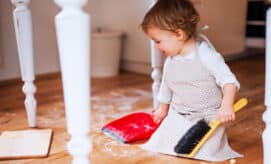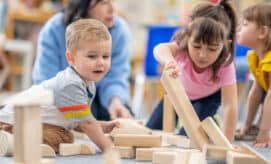Children’s sense of independence emerges early in toddlerhood, well before their ability to self-regulate and manage emotions. The frustration they experience at this developmental stage can quickly turn into big emotions expressed as challenging behaviors. As early childhood care and learning providers, we know that certain situations tend to trigger this normal, but challenging behavior.
Little ones can become particularly frustrated during transitions they encounter throughout the day, as they move between activities, people, and places. Examples In ECE environments include arriving at school, getting ready for naptime, or moving from circle time to outdoor play. In this article, we offer ideas for rethinking classroom transition routines to proactively prevent challenging behavior.
Transitions and Challenging Behavior
Why do transitions and challenging behavior so often happen together? An article in NAEYC’s Young Child magazine offers an explanation. “Challenging behavior is more likely to occur when there are too many transitions, when all the children transition at the same time in the same way, when transitions are too long and children spend too much time waiting with nothing to do, and when there are not clear instructions.” Because challenging behavior often catches us off guard, we respond to it after it has occurred. But, if we can take a closer look at our environment and routines, we might be able to anticipate stressful situations and make proactive changes that prevent challenging behavior from occurring altogether.
Setting Children Up for Success
It is useful to consider how transitions look in your classroom and how they are communicated to the children in your care. Transitions should be announced ahead of time in clear, understandable terms so that children know what to expect and what will be expected from them. This pre-transition preparation helps set children up for success.
Tips for Creating Supportive Routines
As you think about your schedule, consider the flow of the day – Are there particular pain points in your routine? Are there times that transitions can be eliminated? Talk with your co-teachers about times of the day that feel especially stressful and see if you might be able to collaborate on a solution. Some of the ideas described below might be helpful in your classroom.
1. Consider Your Instructions
Sometimes in the business of a day with young children, we can forget to slow down our instructions. During times of transition, it is important that we don’t overwhelm children with too much information at once. For example, rather than saying, “let’s put away our toys in these baskets, and then line up by the door,” break it down into two steps. Start with encouraging children to put their things away, and when that task is finished, stand by the door and invite them to line up in front of you. It can be especially helpful if you make the transition into a game, by asking questions like “how quickly do you think we can put away all of these toys?” Phrasing your instructions as a question or a challenge makes the routine more fun and inviting.
For young children who are still developing their language skills, getting too much information at once can make it difficult to keep track. Remember to slow down, speak in a calm voice, and use words the children will understand.
2. Use a Visual Schedule
Visual schedules use pictures and images to help children recognize each classroom routine. They are a great tool for helping children anticipate each activity within the flow of the day.
The Center on the Social and Emotional Foundations for Early Learning (CSEFEL) explains that, “just as adults use calendars, grocery lists, and ‘to do’ lists to enhance memory, children also benefit from visual reminders.” Visual schedules help children to understand exactly what is expected of them and can be referred to later in order to reinforce understanding. If you are interested in creating a visual schedule for your classroom, here are some resources that you might find helpful:
3. Talk About Feelings
Transitions can provide an opportunity for social-emotional learning and skill-building. If a child seems upset during a transition, talk to them about their feelings and help them find a solution. Here is an example, “You’re feeling sad about cleaning up your blocks. I wonder if we can save what you were working on so that you can keep building later. Can we find a safe place to keep it?”
These conversations help children to feel recognized and supported in their experience. It also helps them to develop their emotional language, while encouraging problem-solving and emotional regulation.
4. Encourage Relationship-Building
Because transitions often occur as a group, they provide an opportunity for children to connect with their peers. NAEYC explains, “Promoting friendship skills can make transitions easier for children: have children find a buddy to sit with, walk down the hall in pairs, work with a friend to clean up, choose a friend to play with, and so on.”
When children clean up, they can work together with their friends to put all of their toys away. One child might help another to get their coat on to go outside or put their mat away after nap time. Transition routines can be a time for connecting and building relationships as children collaborate, communicate, and find ways to help each other.





